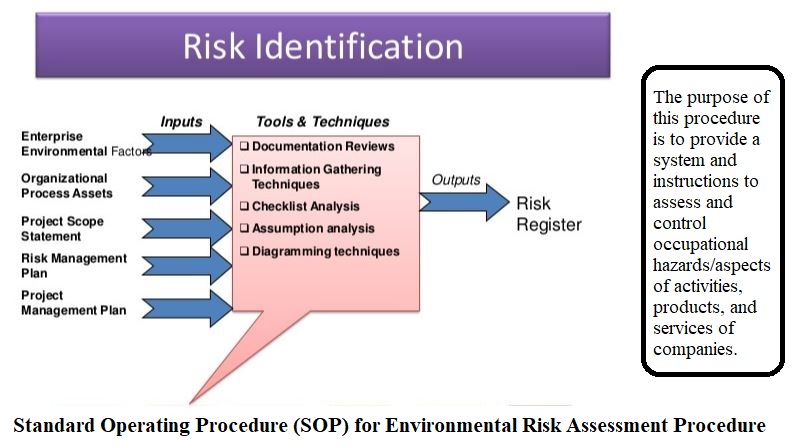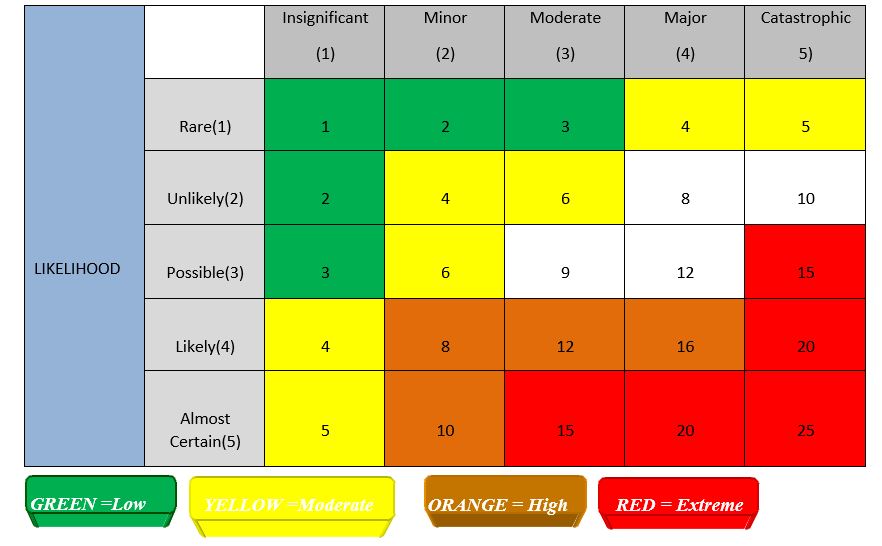
This SOP is to establish a systematic and standardized process for conducting environmental risk assessments to identify, evaluate, and mitigate potential SOP for Environmental Risk Assessment Procedure associated with activities, processes, or products within the organization.
1 PURPOSE of SOP for Environmental Risk Assessment Procedure
The purpose of this procedure is to provide a system and instructions to assess and control occupational hazards/aspects of activities, products, and services of www.pharmaegg.com group of companies. This includes to.
- Evaluate the associated risks and environmental impacts using the risk assessment matrix and prioritize them.
- Reduce the risks by controlling hazards and environmental aspects using appropriate engineering and administrative controls.
2 SCOPE
This procedure applies to all environmental aspects of company’s activities products and services. SOP for Environmental Risk Assessment Procedure
3 ROLES & RESPONSIBILITIES
| Roles | Responsibilities |
| HSE Executive | Health & Safety Executive (HSE) team is primarily responsible to conduct the risk assessment of environmental aspects. This is almost the same team that identified the initial aspects. |
| QA Manager | To ensure the compliance of this SOP for Environmental Risk Assessment Procedure |
4 PROCEDURES
4.1 General SOP for Environmental Risk Assessment Procedure
The purpose of risk assessment of environmental aspects is to select a group of aspects that will become the focus of the EMS, and for which our company will consider implementing special controls and monitoring systems and may develop environmental objectives and targets. This group of aspects defines the direction of our environmental effort and allocation of resources for the protection of the environment.
The aspects/ hazards that may have an impact on environment, occupational health and safety resulting from facility’s’ activities are listed down in the risk registers. Risk ranking exercise is conducted to evaluate the significance of each of the identified aspect/hazard. The identified ‘significant aspects / hazards and their impacts’ are linked either with objectives and targets or controls will be suggested to reduce the impacts.
4.2 Risk Assessment Process
Generally, in HSE aspect / hazard screening process, each aspect / hazard is scored with respect to its severity (or consequence) and the probability of occurrence. This assessment is based on professional judgment and historical experience.
4.3 Assessment of Consequences/Severity
The consequences which arise from an occurrence of the hazard are assessed for the workplace or project and rated according to the table below.
| Insignificant (1) | Minor (2) | Moderate (3) | Major (4) | Catastrophic (5) | |
| HEALTH & SAFETY | First aid treatment | medical treatment | Classified injury (LTI or restricted work case) | Fatality or severe permanent disability. | Multiple fatalities/health effects to> 50persons |
| ENVIRONMENT& HERITAGE | Limited damage to area of low significance | Minor short- term damage to environmental/heritage area | Moderate effects on environment/heritage | Significant environmental/ heritage damage | Severe damage to environment/ heritage with long-term effects |
| COMMUNITY/MEDIA/ GOVERNMNET | Public concern restricted toLocal complaints | Minor, adverse Local public or media attention and complaints | Attention from media and/or heightened concern from community | Significant Adverse national media/ public attention | Serious public or media outcry |
| LOSS/DAMAGE | Damage<$1,000 | Damage>$1,000 | Damage> $10,000 | Damage>$20,000 | Damage> $50,000 |
4.4 Assessment of Likelihood/Frequency of Occurrence
On completion of the hazard identification, the likelihood of occurrence is assessed and rated as follows.
4.5 Assessment of Significance Risk and Risk Ranking Matrix
Using the above definitions included in Tables for severity of an HSE impact and likelihood of an occurrence, an overall significance for each identified aspect is obtained by using Risk Ranking Matrix, below.
| RATING | DESCRIPTION | DETAILS |
| 1 | Rare | Improbable |
| 2 | Unlikely | Happens irregularly (almost never) |
| 3 | Moderate | Has happened(occasionally) |
| 4 | Likely | Happens regularly (often) |
| 5 | Almost certain | Happens every time we operate. |

4.6 Putting Risk Controls in Place.
The control measures are not considered at the first time while assessment is being done to maintain HSE Risk register. The control measures should be considered while revising the aspects/ hazards once they are put into practice. The controls provided to each significant aspect / hazard should minimize the
risk to the levels of either moderate or low i.e. the residual risk should not exceed “moderate limit”.
During the course of Aspect / Hazard assessment if risk ranking reaches to very high or high in most of the cases, remedial measures would be the responsibility of HSE team to assess activity according to risk ranking and provide control accordingly or making management programs for such activity to reduce its risk or team leader of particular section/department may seek advice from HSE team and take necessary controlling actions for mitigation of identified aspects / hazards using their own available resources. All those risk(s) with very high or high ranking are considered un-tolerable and needs to be minimized with appropriate engineering and administrative controls. Separate Management Plans shall be established for all such risk(s) to clearly identify from tolerable risks and will usually be addressed by HSE Team.
4.7 Reviewing Risk Control
It is necessary to monitor work activities after new risk controls have been implemented to ensure that they have eliminated or reduced the risk as planned and those additional risks have not been introduced. Maintenance of plant and equipment introduced to lessen the risk must ensure for ongoing safety. Training must be provided, and records of training maintained.
4.8 Revision Frequency of Risk Register
It is suggested that HSE Risk Register shall be updated least annually. The risk register shall also be updated when new products are introduced or purchased, new process, function and activity is started any change in legislative and regulatory requirements has occurred, changes that may pose serious threat to company / corporate reputation etc. If such changes have noticed before revision period of risk register it must be accounted for and incorporated in risk register without further delay and with prior intimation to concerned HSE Team Representative.

